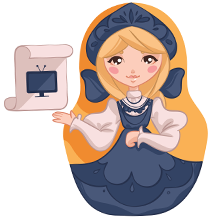Blog about successful marketing strategies in russia
How Does the Product Placement Work in Russia?


MEDIA BUYING
Share this Post
From year to year, advertising technologies are becoming more and more perfect, they are deeply penetrating into all spheres of human life, and it is increasingly difficult for an ordinary person to avoid contact with advertising in his life. However, at the same time, there is a growing rejection of people for advertising; people's minds are configuring not to notice advertising where the person has become accustomed to seeing it. Therefore, the importance of unobtrusive methods of promotion that does not cause negative attitude of the audience is increasing. One of these unobtrusive ways is the Product placement mechanics. One can read on the features of Product placement in Russia in the RMAA Group blog.
.jpg)
Product placement as an advertising device when props used by the heroes of films, telecasts, video clips, books, games, pictures and illustrations have a commercial analogue existing in reality. As a rule, when the product placement occurs, a demonstration of the advertised product or its logo takes place, the product is being mentioned in a positive manner, slogans are mentioned, artistic techniques that are already known to the audience are used for advertising the product, or even the product as a necessary element of the plot is used.
The United States is the homeland of product placement, and the United States remains the leader in the volume of product placement budgets. The results of a study by PQ Media show that advertisers around the world spend more than $ 7 billion a year promoting television and film products, the US share in the total amount is 60 percent ($ 4.3 billion).
.png)
Over time, product placement in Russia penetrated into block busters, in series, in television programs and even in books. However, according to observations of experts, product placement in Russia is growing slowly, brands still have little confidence in this method of promotion in Russia because of the questionable quality of Russian films, the unpredictability of the advertising effect and the inability of domestic specialists to make the advertisement of the product really unobtrusive. By the way, this can be considered as one of the main features of product placement in Russia: often no one tries to make advertising hidden, products and logos are shown close-up, heroes say slogans, sometimes the product becomes an important story element.
.jpg)
Pros and cons of product placement
As a technology for promoting goods and services product placement has certain advantages over traditional forms of product offerings:
- psycho-emotional: positive perception, unobtrusiveness, integration into an interesting plot, imagery;
- economic: single investment, the possibility of subsequent free repetitions;
- organizational and technical: mass coverage, the viewer does not switch the film and does not flip through the pages of the book with the posted product.
These advantages provide product placement with a greater degree of impact, reliability and depth of penetration into the mind of the consumer.
However, product placement has a number of disadvantages in terms of technology:
- uncertainty as to how, when and where the product placement carrier will "work";
- dependence on the context of the work, to the extent of obtaining the opposite effect;
- the time gap between the investment of funds, the release of the film (book) and the achievement of the result;
- lack of precise criteria and methods for assessing effectiveness.
Let's consider examples of using product placement in Russia.
.jpg)
Shots from the commercials of MTS, associated with the film "New Year's tariff"
Product as a participant in the plot
One of the most striking examples of product placement in Russia is the film "The New Year's Tariff" of 2008, sponsored by the mobile operator MTS. The film turned out to be almost one big advertisement of the really existing "New Year" tariff. MTS products have become an integral part of the story. The heroes used a new tariff plan, as well as all kinds of mobile services: SMS, MMS, data transmission over the Internet, video calls. Later shots from the film were used in MTS commercials. It was reported that all this cost the company 11.3 million rubles.
And here is an example of less intrusive advertising: the film "Peter FM", in which the whole story revolves around the Samsung phone, which the main heroine of the film loses, and the other hero finds and during the whole film tries to return. In the course of the film, all the basic functions of the E800 model are demonstrated. In the film there is a so-called verbal product placement. In one episode, the hero says this phrase: "I gave you the new Samsung", stressing the word Samsung.
.jpg)
Shot from the film "The New Year's Tariff"
Product placement in Timur Bekmambetov' films
Timur Bekmambetov is one of the most famous film makers in Russia, who has made a number of hit blockbusters for Russian cinema. However, his films are also known for a large number of hidden advertisements for a variety of products. It's about the films "Night Watch" and "Day Watch". "Night Watch" is known to have collected about 500 thousand dollars from advertisers, and "Day Watch" raised 3 million dollars. In both films, at least 30 brands are advertised.
Bekmambetov's film "The Irony of Fate. Continuation" is also worth noting. It is a remake of the cult Soviet film, which because of the abundance of brands is jokingly called "advertising with a happy end." Throughout the film, the hero of Sergei Bezrukov walks around in the black and yellow scarf of the company "Beeline", for which he works on the plot. From the very beginning of the film, the audience watched the advertisement of Toyota Corolla and the Aeroflot airline. The main thing on the holiday table is Calve mayonnaise, as present heroes give only Nestle chocolates, and the only vodka drunk is Russian Standard.

Shot from the film "The Irony of Fate. Continuation'. The hero wears the scarf in the corporate colors of the cellular operator "Beeline".
Product placement as an element of satire
It is interesting that the volume of product placement in Russian films has reached such a scale that this tool itself has already been mocked in a series of parody films "The Best Film". For example, in the film "The Best Film 2", parodying the film "The Irony of Fate. Continuation", a huge amount of advertising was shown with concentrating special attention on it. Especially often in the frame was vodka "Putinka". By the way, it should be noted that for vodka brands, as well as for strong alcohol in general, product placement is one of the few ways of promotion, not limited by law.
.jpg)
Shot from the film "The Best Film 2"
Product placement in television projects
In Russian TV shows, product placement is used very actively. Basically we are talking about three types of programs. Firstly, these are the so-called "shows-assistants" – shows, in which it is told how to do something: prepare food, do repairs, equip a garden plot, and so on. In these programs, product placement looks quite natural, because in order to do repairs, you need building materials, and to prepare food - you need appliances.
The second type of program is a reality show. Since the show participants spend all their time in the frame, they do a lot of different things, use a lot of different goods and products, the possibilities for product placement here are simply unlimited. Russian most important reality show Dom-2 (on air since 2004 to present day) has long and very confidently promoted dozens of brands ranging from food and cosmetics to building materials and complex technical devices.
The third type of program is, of course, series. Almost any Russian TV series of the past 10 years has episodes with product placement, and the tool itself, according to experts, recovers up to 20% of the cost of shooting. Variants of their use are numerous. For example, in one of the scenes of the detective series "March of Turetskiy" heroes turned on the radio in the car, listened to the advertisement of the Peugeot car, and also the car dealership with the indication of its coordinates and only after that they continued the conversation. In addition, the main character drove a car of this brand and recommended it to his friends.
.png)
A shot from the telecast "Dom 2"
Product placement in books
In Russia, product placement has a very specific development. Russian know-how is in the fact that advertisers are offered a flattering mention of their products in fiction. For the first time such method of promotion of goods was tested in 2003 for chicken manufactured products "Golden Cockerel". Another novel written by Darya Dontsova was called - "Golden cockerel fillet", and the main character of the book could not imagine a life without this product. Today, there is the possibility of advertising in the works of many authors of popular literature.
.jpg)
Cover of Daria Dontsova's book "Golden cockerel fillet"
Advertising positional options used in online cinemas
Technology of product placement is quite actively used in Russia. Goods are advertised in movies, series, TV programs and even in books, and in any forms: verbal, audial, visual, story. However, the volume of the product placement market in Russia today is far from the maximum and retains great potential for development. RMAA Group specialists will select the optimal placement for your product in Russian films, TV series and TV shows.
Join 2,000+
of your Peers!
You will be the first to know about Russian marketing insights, news and updates from our agency. Stay tuned!
Get our latest articles delivered to your email inbox and get our exclusive White Paper
"A media buyer's quick guide for effective work in Russia"
for FREE!
How does the Media-Buying Market in Russia Work?
More about the current ecosystem of the Russian advertising market

Ready to partner with the specialists in Russian marketing and advertising?
About the Author
Digital Strategist. Head of one of the project groups at RMAA. Maria started her journey in digital marketing in 2009.
Join 2,000+ of your Peers!
Get our latest articles delivered to your email inbox and get our exclusive White Paper "A media buyer's quick guide for effective work in Russia?" for FREE!
You will be the first to know about Russian marketing insights,
news and updates from our agency.
Stay tuned!















